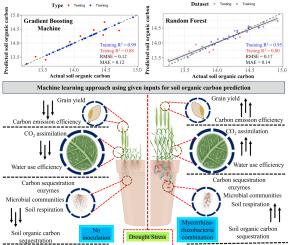Amplification effects of AM fungus and rhizobacteria on carbon efficiency in wheat-soil system under drought stress via priming rhizosphere activities
IF 5
2区 农林科学
Q1 SOIL SCIENCE
引用次数: 0
Abstract
Background
Arbuscular mycorrhizal fungi (AMF) and plant growth-promoting rhizobacteria (PGPR) are essential for improving crop yield and drought adaptation. Yet, their combined potential to increase carbon efficiency remains unexplored.
Methods
To address this issue, a growth environment-controlled experiment was conducted to investigate the synergetic impacts of Rhizophagus irregularis (strain GSICC 63801) and Bacillus amyloliquefaciens (strain GSICC 32826) on carbon efficiency in the wheat-soil system under the well-watered (WW; 80 % field water capacity, FWC), moderate water stress (MWS; 50 % FWC), and severe water stress (SWS; 35 % FWC), synergized with machine learning.
Results
The data indicated that the joint AMF-PGPR inoculation showed significantly stronger soil carbon sequestration than the sole inoculation (n = 3, p < 0.05), which became more evident along with drought stress intensity. AMF-PGPR co-inoculation significantly improved soil organic carbon by 5.42 % under SWS compared to CK (non-inoculation) due to a significant increase in microbial biomass carbon, particulate organic carbon, easily oxidizable carbon, and dissolved organic carbon. AMF-PGPR co-inoculation significantly enhanced the activities of key carbon sequestering enzymes (Xylosidase, β-Glucosidase, and cellobiohydrolase), with increasing abundance of microbial communities, compared with the sole inoculation and CK. The AMF-PGPR combination improved carbon emission efficiency, CO2 assimilation, and net carbon balance despite increased soil respiration. Increasing water use efficiency ultimately enhances wheat grain yield, particularly under SWS. Also, gradient boosting machine (MSE = 0.12, R2 = 0.99 training, R2 = 0.88 testing) outperformed random forest regression (MSE = 0.14, R2 = 0.95 training, R2 = 0.80 testing) in predicting SOC, validated by structural equation modeling (R2 = 0.86).
Conclusion
These results position the AMF-PGPR combination as a green solution to improve carbon efficiency in the wheat-soil system.

干旱胁迫下AM真菌和根瘤菌对小麦-土壤系统碳效率的放大效应
丛枝菌根真菌(AMF)和促进植物生长的根瘤菌(PGPR)对提高作物产量和适应干旱至关重要。然而,它们提高碳效率的综合潜力仍未得到探索。方法为解决这一问题,通过生长环境控制试验,研究了在水分充足(WW; 80%田间水量,FWC)、中度水分胁迫(MWS; 50% FWC)和重度水分胁迫(SWS; 35% FWC)的协同作用下,非常规食根菌(GSICC 63801)和解淀粉芽孢杆菌(GSICC 32826)对小麦-土壤系统碳效率的影响,并结合机器学习进行了研究。结果AMF-PGPR联合接种对土壤固碳效果显著强于单独接种(n = 3, p < 0.05),且随着干旱胁迫强度的增加,固碳效果更加明显。AMF-PGPR共接种可显著提高SWS下土壤有机碳含量,其微生物量碳、颗粒有机碳、易氧化碳和易溶解有机碳含量显著高于CK(未接种),显著提高土壤有机碳含量5.42%。与单独接种和对照相比,AMF-PGPR共接种显著提高了关键固碳酶(木糖苷酶、β-葡萄糖苷酶和纤维素生物水解酶)的活性,微生物群落丰度增加。AMF-PGPR组合虽然增加了土壤呼吸,但提高了碳排放效率、CO2同化和净碳平衡。提高水分利用效率最终会提高小麦产量,特别是在SWS条件下。此外,梯度增强机(MSE = 0.12,训练时R2 = 0.99,测试时R2 = 0.88)在预测SOC方面优于随机森林回归(MSE = 0.14,训练时R2 = 0.95,测试时R2 = 0.80),并通过结构方程模型(R2 = 0.86)进行验证。结论AMF-PGPR组合是提高小麦-土壤系统碳效率的绿色解决方案。
本文章由计算机程序翻译,如有差异,请以英文原文为准。
求助全文
约1分钟内获得全文
求助全文
来源期刊

Applied Soil Ecology
农林科学-土壤科学
CiteScore
9.70
自引率
4.20%
发文量
363
审稿时长
5.3 months
期刊介绍:
Applied Soil Ecology addresses the role of soil organisms and their interactions in relation to: sustainability and productivity, nutrient cycling and other soil processes, the maintenance of soil functions, the impact of human activities on soil ecosystems and bio(techno)logical control of soil-inhabiting pests, diseases and weeds.
 求助内容:
求助内容: 应助结果提醒方式:
应助结果提醒方式:


